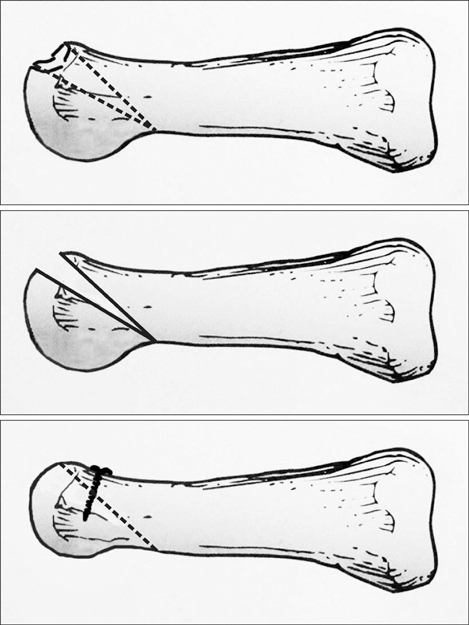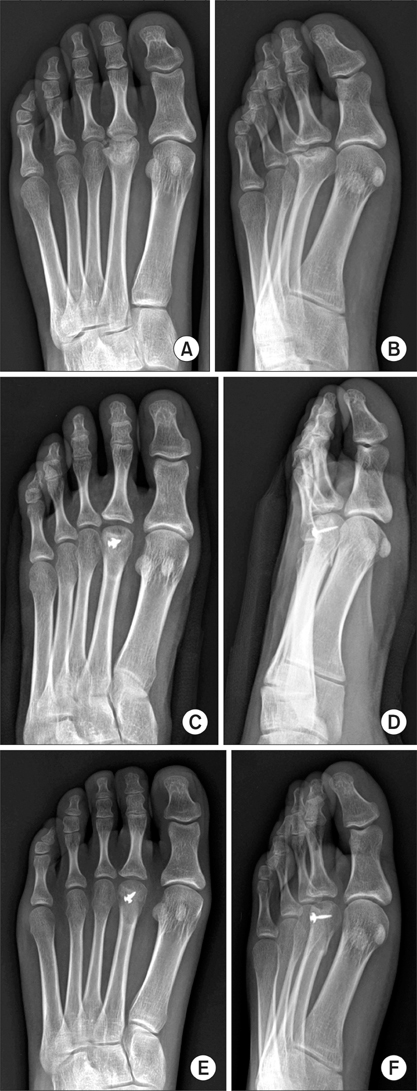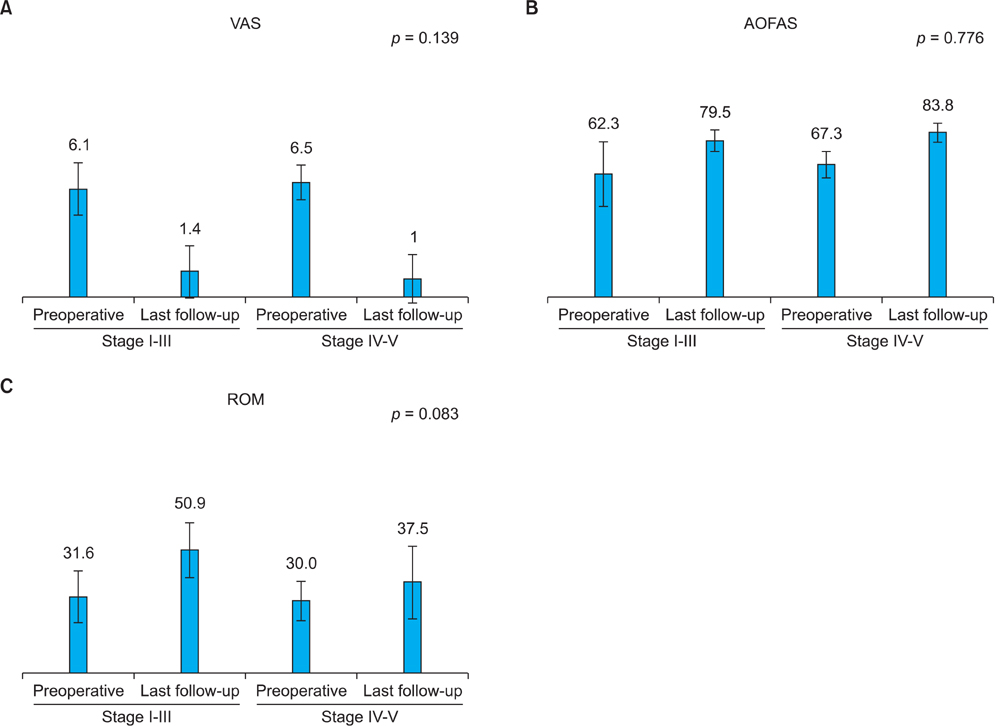Clin Orthop Surg.
2012 Dec;4(4):300-306. 10.4055/cios.2012.4.4.300.
Modified Weil Osteotomy for the Treatment of Freiberg's Disease
- Affiliations
-
- 1Department of Orthopaedic Surgery, Busan Veterans Hospital, Busan, Korea.
- 2Department of Orthopaedic Surgery, Yonsei University College of Medicine, Seoul, Korea. ljwos@yuhs.ac
- KMID: 1719298
- DOI: http://doi.org/10.4055/cios.2012.4.4.300
Abstract
- BACKGROUND
Numerous metatarsal osteotomies have been developed for the treatment of Freiberg's disease. The purpose of this study was to evaluate the clinical outcomes of modified Weil osteotomy in the treatment of Freiberg's disease.
METHODS
From November 2001 to July 2008, nineteen patients (twenty feet), treated surgically for Freiberg's disease, were included in this study. The average age of the patients was 33.6 years (range, 17 to 62 years), the mean follow-up period was 71.6 months (range, 41 to 121 months). Clinical outcomes were evaluated according to visual analogue scale (VAS), American Orthopaedic Foot and Ankle Society (AOFAS) lesser metatarsophalangeal-interphalangeal scale, the patients' subjective satisfaction and range of motion (ROM) of metatarsophalangeal (MTP) joint. In the radiologic evaluation, initial metatarsal shortening by Freiberg's disease compared to opposite site, metatarsal shortening after modified Weil osteotomy compared with preoperative radiography and term for radiologic union were observed.
RESULTS
VAS showed improvement from 6.2 +/- 1.4 to 1.4 +/- 1.5 at last follow-up (p < 0.0001). Points of AOFAS score increased from 63.3 +/- 14.9 to 80.4 +/- 5.6 (p < 0.0001). ROM of MTP joints also improved from 31.3 +/- 10.1 to 48.3 +/- 13.0 degrees at last follow-up (p < 0.0001). According to Smillie's classification system, there was no significant improvement of VAS, AOFAS score and ROM between early stages (stage I, II, and III) and late stages (stage IV and V). Out of twenty cases, nineteen (95%) were satisfied, reporting excellent or good results.
CONCLUSIONS
Modified Weil osteotomy is believed to be a useful method for the treatment of Freiberg's disease, not only in the early stages but also in the late stages. It relieves pain and improves function via shortening of metatarsals and restoration of MTP joint congruency.
MeSH Terms
-
Adolescent
Adult
Female
Humans
Male
Metatarsal Bones/pathology/radiography/surgery
Metatarsus/abnormalities/pathology/radiography/surgery
Middle Aged
Osteochondritis/*congenital/pathology/radiography/surgery
Osteotomy/*methods
Pain Measurement
Range of Motion, Articular
Statistics, Nonparametric
Treatment Outcome
Figure
Cited by 2 articles
-
Treatment of Freiberg’s Disease Using the Shortening Effect of the Modified Weil Osteotomy
Tae-Hoon Lee, Yeong-Hyeon Lee, Gil-Yeong Ahn, Il-Hyun Nam, Kyung-Jin Lee, Sang-Won Woo
J Korean Foot Ankle Soc. 2021;25(4):165-170. doi: 10.14193/jkfas.2021.25.4.165.Outcome of Extraarticular Dorsal Closing Wedge Osteotomy for Freiberg’s Disease
Jun Young Lee, Woong Hee Kim, Sung Jung, Sung Hun Yang
J Korean Foot Ankle Soc. 2016;20(3):126-130. doi: 10.14193/jkfas.2016.20.3.126.
Reference
-
1. Freiberg AH. Infraction of the second metatarsal: a typical injury. Surg Gynecol Obstet. 1914. 19:191–193.2. Smillie IS. Freiberg's infraction (Kohler's second disease). J Bone Joint Surg Br. 1957. 39(3):580.3. Sproul J, Klaaren H, Mannarino F. Surgical treatment of Freiberg's infraction in athletes. Am J Sports Med. 1993. 21(3):381–384.
Article4. Morandi A, Prina A, Verdoni F. The treatment of Kohler's second syndrome by continuous skeletal traction. Ital J Orthop Traumatol. 1990. 16(3):363–368.5. Freiberg AA, Freiberg RA. Core decompression as a novel treatment for early Freiberg's infraction of the second metatarsal head. Orthopedics. 1995. 18(12):1177–1178.
Article6. Freiberg JA. The diagnosis and treatment of common painful conditions of the foot. Instr Course Lect. 1957. 14:238–247.7. Miyamoto W, Takao M, Uchio Y, Kono T, Ochi M. Late-stage Freiberg disease treated by osteochondral plug transplantation: a case series. Foot Ankle Int. 2008. 29(9):950–955.
Article8. Helal B, Greiss M. Telescoping osteotomy for pressure metatarsalgia. J Bone Joint Surg Br. 1984. 66(2):213–217.
Article9. Smith TW, Stanley D, Rowley DI. Treatment of Freiberg's disease: a new operative technique. J Bone Joint Surg Br. 1991. 73(1):129–130.
Article10. Gauthier G, Elbaz R. Freiberg's infraction: a subchondral bone fatigue fracture: a new surgical treatment. Clin Orthop Relat Res. 1979. (142):93–95.11. Kinnard P, Lirette R. Dorsiflexion osteotomy in Freiberg's disease. Foot Ankle. 1989. 9(5):226–231.
Article12. Kinnard P, Lirette R. Freiberg's disease and dorsiflexion osteotomy. J Bone Joint Surg Br. 1991. 73(5):864–865.
Article13. Chao KH, Lee CH, Lin LC. Surgery for symptomatic Freiberg's disease: extraarticular dorsal closing-wedge osteotomy in 13 patients followed for 2-4 years. Acta Orthop Scand. 1999. 70(5):483–486.
Article14. Lee SK, Chung MS, Baek GH, Oh JH, Lee YH, Gong HS. Treatment of Freiberg disease with intra-articular dorsal wedge osteotomy and absorbable pin fixation. Foot Ankle Int. 2007. 28(1):43–48.
Article15. McGlamry ED, Ruch JA. Status of implant arthroplasty of the lesser metatarsophalangeal joints. J Am Podiatry Assoc. 1976. 66(3):155–164.
Article16. Lui TH. Arthroscopic interpositional arthroplasty for Freiberg's disease. Knee Surg Sports Traumatol Arthrosc. 2007. 15(5):555–559.
Article17. Carmont MR, Rees RJ, Blundell CM. Current concepts review: Freiberg's disease. Foot Ankle Int. 2009. 30(2):167–176.
Article18. Vandeputte G, Dereymaeker G, Steenwerckx A, Peeraer L. The Weil osteotomy of the lesser metatarsals: a clinical and pedobarographic follow-up study. Foot Ankle Int. 2000. 21(5):370–374.
Article19. Huskisson EC. Measurement of pain. Lancet. 1974. 2(7889):1127–1131.
Article20. Kitaoka HB, Alexander IJ, Adelaar RS, Nunley JA, Myerson MS, Sanders M. Clinical rating systems for the ankle-hindfoot, midfoot, hallux, and lesser toes. Foot Ankle Int. 1994. 15(7):349–353.
Article21. Hofstaetter SG, Hofstaetter JG, Petroutsas JA, Gruber F, Ritschl P, Trnka HJ. The Weil osteotomy: a seven-year follow-up. J Bone Joint Surg Br. 2005. 87(11):1507–1511.22. Helal B, Gibb P. Freiberg's disease: a suggested pattern of management. Foot Ankle. 1987. 8(2):94–102.
Article23. Jones S, Al Hussainy HA, Ali F, Betts RP, Flowers MJ. Scarf osteotomy for hallux valgus: a prospective clinical and pedobarographic study. J Bone Joint Surg Br. 2004. 86(6):830–836.
- Full Text Links
- Actions
-
Cited
- CITED
-
- Close
- Share
- Similar articles
-
- Treatment of Freiberg’s Disease Using the Shortening Effect of the Modified Weil Osteotomy
- Weil Osteotomy for Freiberg's Disease
- Dorsal Closing Wedge Osteotomy in Freiberg's Disease
- Dorsal Wedge Osteotomy Using Bioabsorbable Pins for the Treatment of Freiberg's Disease
- Autogenous Osteochondral Graft for Freiberg's Disease: A Case Report




